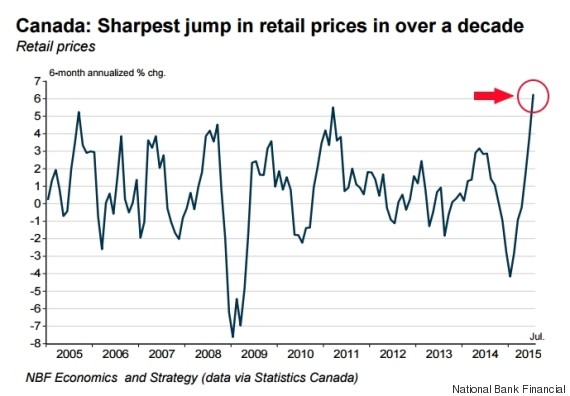 Retail prices are rising at their fastest rate in at least a decade and there will be more price pressure ahead thanks to a falling loonie, analysts say.
Retail prices are rising at their fastest rate in at least a decade and there will be more price pressure ahead thanks to a falling loonie, analysts say.Sticker prices in Canada have been rising at an annual rate of 6.3 per cent over the past six months, the fastest rate in records going back to 2004.
And “you’re going to see this for a while,” says Krishen Rangasamy, senior economist at National Bank Financial.
That’s because the loonie likely isn’t done falling, and retailers will likely face even higher import costs going forward.
The Canadian dollar hit an 11-year low on Tuesday and continued to sink in early trading on Wednesday, hovering around 74.76 cents U.S.
But Rangsamy sees the loonie falling further still, to around 72.5 cents U.S., and that will put more upward pressure on retail prices.
He says beyond the higher cost of imported goods, there’s another factor: The low loonie is pushing cross-border shoppers back home, pushing up demand in Canada.
But even with that effect, the latest retail sales numbers were disappointing, showing a 0.5 per-cent month-on-month increase in July, according to data from StatsCan released Wednesday. Analysts had been expecting 0.7 per cent growth.
All the growth came from auto sales, which jumped 2 per cent. Stripping out autos, retail sales were flat for the month.
But when it comes to price hikes, the worst may be ahead. An internal report from the Retail Council of Canada, obtained recently by the Globe and Mail, says retailers have so far been “selective” in raising their prices, but they may not be able to hold off on price hikes much longer.
The greatest effects of the loonie’s fall are “still to come,” the report said.
Another factor pushing prices upwards is the major consolidation in Canadian food retail, particularly the merger of Sobeys and Safeway, as well as Loblaws’ purchase of Shoppers Drug Mart.
With fewer players in the market, grocers are feeling less pressure to keep prices low, CIBC World Markets said in a report this summer.
“We suspect that even without cost inflation, grocers would have taken advantage of an easier market to raise prices, although maybe not to the current extent,” the report said.
“Already we have seen some coordination of advertising programs to avoid direct item conflicts,” the report said.
“But more importantly, the reduction in the number of competitors in both drug and food makes price checking and price signalling that much easier.”
Original Article
Source: huffingtonpost.ca/
Author: Daniel Tencer

No comments:
Post a Comment